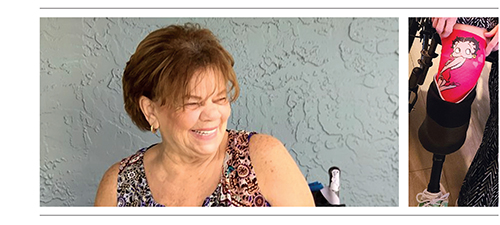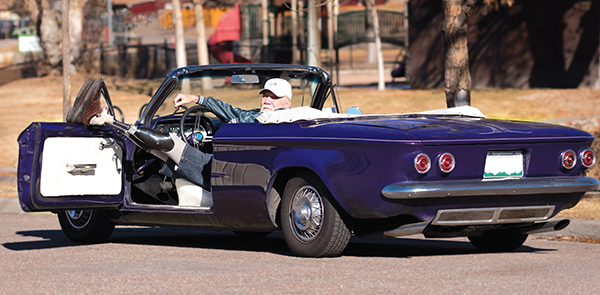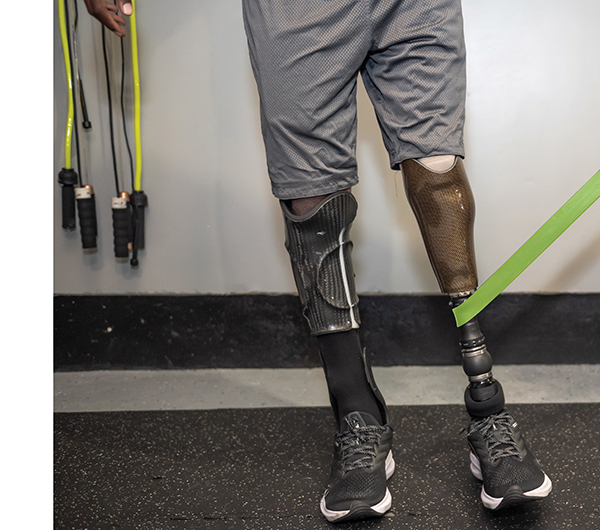By Rene Agredano
New technologies and clinical techniques are helping amputees over 70 years old achieve a higher quality of life.

When Lillian Velasquez retired, she made the same choice so many New Yorkers do: She moved to Florida. With a new home in the beachfront community of Palm Bay and no job or family responsibilities, the effervescent New Yorker looked ahead to leisurely days and a life of carefree enjoyment.
That was the plan, anyway. But a couple of years ago, Velasquez’s life took a dramatic turn.
“When the pandemic started [in March 2020], my pain started with it,” she says. “Everything went downhill from that moment on.” After all efforts failed to slow the progress of peripheral vascular disease in her right leg, Velasquez ran out of options. “The doctor came in, and I knew what he was going to tell me. He said, ‘You have no choice.’” Amputation below the knee was the only way out of the excruciating pain that consumed every waking moment and threatened her long-term well-being.
Velasquez hadn’t planned to spend her golden years going through the hard work of adapting to limb loss. She was determined to maintain her independence and stay socially active, but she wasn’t sure how—or whether—that would be possible as an amputee. “I cried, my kids cried,” she recalls. “But then I realized it could be worse. I’m alive.”
Even though she’s a natural-born optimist, Velasquez has needed lots of encouragement and support to rise to the challenge. One year after her amputation, she’s well on her way to the sunny, restful retirement she originally sought when she moved to Florida. Her experience illustrates that good outcomes are more attainable for older amputees than it might first appear. And thanks to cutting-edge technology and modern clinical practices, happy endings are becoming increasingly common.

Set Appropriate Goals
According to Hanger Clinic prosthetist Derek Kinsella, it’s critical for older amputees to set incremental goals that move them gradually toward a better quality of life.
“When you’re a little bit older, it takes longer to come back,” explains Kinsella, who practices in Lancaster, Ohio. “There’s a lot more atrophy that goes on with the postural muscles, so there’s a lot of work that goes into getting back proper posture and gait.”
When Kinsella meets a new patient, he doesn’t want to know their age, because that number might exert too much influence on his thought process. Instead, he looks at the conditions that got the person to where they are, then co-creates a plan that gets them where they want to be. “We never want to limit anyone,” he says. “If someone is 75 and wants to run a marathon but never has in their life, I’m going to do everything I can to get them there.”
Kinsella encourages older amputees to take a slow, steady approach in the path to mobility and to give themselves the grace and time to achieve their goals. He recommends setting small, specific activity targets and celebrating each milestone. One by one, each accomplishment builds motivation and strengthens resilience when the inevitable setbacks occur. Kinsella describes a recent patient who quickly met his goal of walking without assistance soon after receiving his first prosthesis. But when he lacked the stamina to walk more than a few feet, this patient became frustrated. The well-fitting device was causing no pain, so Kinsella coached him through the disappointment and proposed a new goal to build strength and endurance. “We talked about getting a daily calendar and setting smaller goals, every single day,” Kinsella says. “We’ve done it with patients before, and it works pretty well.”

Velasquez is also a believer in goal setting. She constantly creates new ones to get outside of her comfort zone and into the wider world. Ditching the walker after rehab was among her first objectives, and she achieved it in almost no time. Now, much like Kinsella’s patient, she’s working on building up her staying power. Things get tough sometimes, but when the sofa calls out to her, she refuses to listen. “I push, I force myself to walk,” she says. “Sometimes that can be very hard. But I get up and I do it anyway.”
When Ray Klomp was struggling through limb-loss rehabilitation nearly ten years ago, he drew motivation from his love of vintage autos. “A doctor told me, ‘You’re going to have to get hand controls for your car,’” says Klomp, now 77. But hand controls would be wildly out of place on Klomp’s gorgeously restored 1963 Chevy Corvair convertible, which once took top honors at a national auto convention. So he learned to operate all three pedals (gas, brake, and clutch) with his prosthetic legs.
“It took me a little while, but I guess I’m kind of stubborn,” Klomp laughs. “If you set your mind to it, you can do the things that are important to you. I’m not going to say everything was always rosy. I’ve had my failures, and there are some things I just can’t do. But you can’t just sit around and tell yourself, ‘I can’t do this and I can’t do that.’ You have to continue pushing on, even through your bad days when you don’t feel like you can get over the hurdles. Some of them are mental, and some are physical. But you can’t just throw your whole life away.”
Stay Mobile and Stay Connected
Younger amputees make prosthetists look good. With stronger, more agile bodies, they can be up and moving almost from the first moment they try on their first devices. But most older amputees don’t progress that quickly or easily, and they shouldn’t expect to.
“Individuals who are older in age tend to have more comorbidities,” says Alberto Esquenazi, a physiatrist and chief medical officer of MossRehab in Lancaster, Pennsylvania. The health issues that accumulate over a lifetime—everything from diabetes to arthritis, coronary disease, gastrointestinal conditions, and more—often reduce people’s mobility whether or not they lose a limb. Those impacts are magnified when someone needs to recover from amputation, Esquenazi says. “As we get older—and this is not true for everyone—we tend to get a little less active. If you’re less active, then you’re bound to have less reserve when you need it in a case like limb loss.”
You’re also at elevated risk for social isolation and depression, Esquenazi adds. That makes it all the more vital for older amputees to maximize their mobility through a doctor-approved fitness program. No matter what medical conditions you may experience, appropriate daily movement keeps you connected with the outside world and leads to a better quality of life.
Esquenazi, who has been an upper-limb amputee since the age of 19, devotes much of his practice to helping amputees get back on their feet through fitness. “Everybody can exercise,” he says. “There may be different levels of it, but you can exercise. We want to be sure that we keep you safe, so we monitor your blood pressure, we monitor your heart rate. We don’t want to push you to a point where we’re pushing you too hard, but we can push you [safely]. We’ve never had a patient who was unable to participate because their heart was not capable of being able to sustain the rehabilitation effort.”
In addition to testing older amputees’ stamina, recovering from limb loss can also trigger pain. Changes in gait and posture redistribute the weight burden throughout the whole body, and repetitive activities can take a toll. That’s a lesson Esquenazi learned firsthand: When he was younger, he never considered that strenuous exertion, such as weekend home-improvement projects, might do long-range damage to his remaining arm.
“I’ve paid for overuse,” he says. “I certainly overuse my left hand much more, and I overuse my right shoulder because I do a lot of movements with it to operate my prosthesis.” Now he cautions patients to be more mindful about how they use their bodies. “Be much more thoughtful about how and when to do repetitive activity,” he says. “I learned you don’t have to do everything on your own. You can be smart about how you shift around tasks.”
Your prosthetist is one of the most important links to a pain-free life. That’s because even if you’re feeling well, subtle changes in your balance or strength can alter how you walk and where you put pressure on your prosthesis and residual limb. Compensating for those changes often leads to chronic pain that restricts your mobility. Your prosthetist can ensure that your prosthetic device is working well with your body and make tune-ups to prevent pain from getting severe. Should pain persist or worsen, a physiatrist like Esquenazi can create a plan to address it. All it takes is a phone call to make it happen.
“Any little question is not a bother to us,” says Kinsella. “That’s our job; that’s why we are here. Who else are you supposed to ask?”
Embrace Technology
If your alarm bells go off when your prosthetist mentions a word like “microprocessor,” don’t panic. You don’t have to be a digital native to reap the benefits of a computer-aided prosthesis. Advanced technology can open the door to better, safer mobility. From knees and feet with special safety features like stumble recovery, to smart prosthetic legs that auto-adjust when you’re walking up or down inclines, modern devices can neutralize the effects of age-related changes such as vascular disease, visual impairment, arthritis, and balance difficulties. “The more technology, the better,” Kinsella enthuses. “The more comfort you’re going to have in the socket, the more activities you’re going to be able to do, the more stability you’ll eventually have.” Although there aren’t any devices specifically designed and marketed for older amputees, your prosthetist can modify an off-the-shelf device with advanced components to support your needs. And if you’re slightly (or even decidedly) technophobic, don’t worry: Using this gear is often as simple as plugging in the device each night to keep it charged.
The benefits of modern technology for aging amputees go beyond the prosthesis. Wearable fitness tracking devices can help you maximize the impact of high-tech limbs. Chelsey B. Anderson, a prosthetist in the University of Colorado’s Department of Physical Medicine and Rehabilitation, encourages amputees to use a lightweight activity tracker such as a FitBit or Apple Watch. “Wearable activity monitoring devices allow for a person to track their daily activity, with real-time feedback to help with making progress and recognizing goal achievement,” she says. Even small goals, like taking 50 extra steps every day, are more easily seen, felt, and celebrated by amputees wearing activity trackers.
Lillian Velasquez is pleased with her own progress so far. She’s making steady improvement in the use of her prosthetic leg, taking daily walks through the neighborhood with her daughter Priscilla. She’s learning how to cook healthier and trying to do more daily activities on her own. She’s even rejoined the labor force part-time, working for a business she directly inspired. When Velasquez complained about the bland, hospital-white amputee socks she was issued after surgery, her son Sidney Muniz launched Amputee Sock Prints. The company creates eye-catching sleeves that slip over a limb or shrinker. In less than a year, the family-run business has attracted an international clientele, shipping orders around the world. Velasquez pitches in, and the role motivates her to keep moving and stay healthy.
“It occupies my brain and keeps it ticking,” she laughs. “I look forward to getting up in the morning and having something to do again, other than cleaning the house.”
Although she hasn’t worked up the courage to join a fitness center or visit a support group with other local amputees, those goals are on her list this year. But staying motivated to follow through isn’t always easy, even for an upbeat person like her.
“Sometimes I get angry,” she says. “But I tell myself that I’m not going to be angry, because I don’t want to spend my energy that way. Getting angry and having a fit is not going to solve the problem. It’s not going to make my leg grow in the middle of the night.” Friends and family have told her they could never be as optimistic as she is, but Velasquez doesn’t consider her attitude extraordinary. “When the moment of truth comes, we gotta do what we gotta do,” she says. “As you get older, you learn more, and hopefully you get smarter and wiser.”
Age Smarter with a Physiatrist
Everybody experiences changes in balance and strength as they age, but compensating can be especially problematic for amputees. “When I was 30, I was getting up and down off the floor, casting people for custom shoes,” says 57-year-old prosthetist Lynn DeCola. “As I’ve gotten older it takes a little bit more to get up off the floor, to carry things, and balance.” Twenty-eight years after losing her leg in a motorcycle accident, DeCola has experienced many physical changes she didn’t expect. Muscle tone in her residual limb has changed. Her first pair of bifocals altered her vision and made her unsteady on her feet. Maintaining physical strength takes more effort. Working with a physiatrist helps to tackle the challenges that come her way.

Physiatrists are medical doctors who specialize in physical medicine and rehabilitation. DeCola not only works with one herself, she strongly encourages her amputee clients to do so as well. “They look at the whole person,” she explains. Physiatrists also offer a large umbrella of services, from prescribing mobility devices to creating personalized fitness programs and deploying an array of pain management strategies.
“We create a structure that really supports the patient,” says physiatrist Alberto Esquenazi. “From having a prosthetist on site, to physiotherapists, occupational therapists, psychologists, and recreational therapists who understand the milieu of working in a team, we focus on the goals of the patient.”
DeCola believes physiatrists are an essential part of any amputee’s care, but particularly for older individuals who need to adjust their limb-loss adaptations as their bodies age. These practitioners take a holistic approach that not only accounts for an amputee’s physical condition but also addresses their home environment, personal likes and dislikes, family support system, financial means, and other life factors.
“We’re going to look at an individual and say, ‘What do we need to do to get that person to function again?’” Esquenazi says. “They might not be able to function the way they did before, but what is the maximum function capacity that we can produce?” A comprehensive care plan is created, the team follows it, and the physiatrist oversees and monitors the effort. Esquenazi appreciates that no two situations are ever alike. “The patient that used to be an avid golf player or tennis player is quite different from the patient who just plays cards with friends now that they’re retired. All of that information is going to create a different approach as to how we interact with those patients, and the goals set for that patient.”
Physiatry is a relatively new specialty in mainstream medicine; DeCola didn’t discover it herself until recently. There are currently about 9,000 active physiatrists in the United States. Visit the American Association of Physical Medicine and Rehabilitation’s website directory to find one near you.



